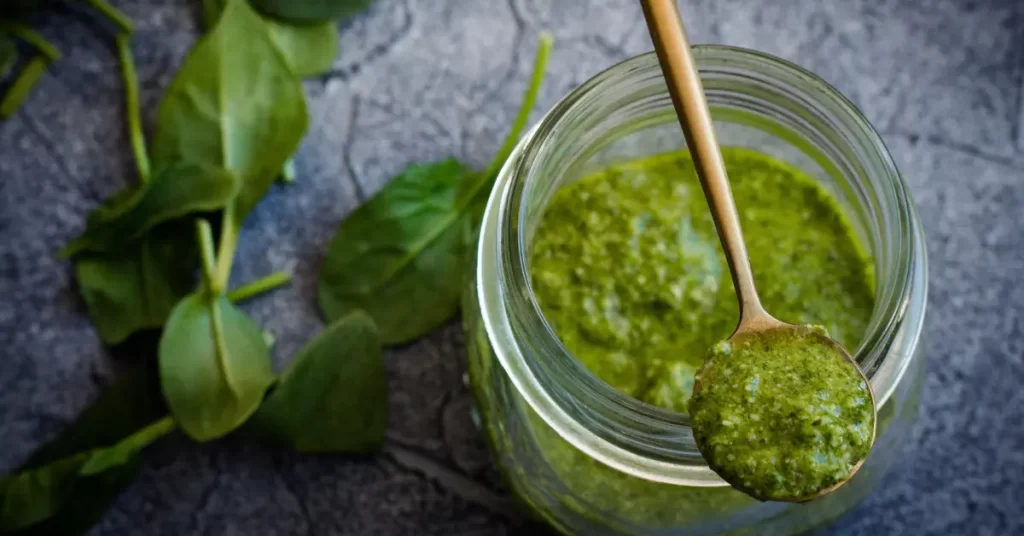Can Dogs Eat Pesto? Some Dog Owners Say Yes, Others No

Do you love pesto just as much as the next person? If so, then you’ll probably be excited to know that can dogs eat pesto?
Pesto is a green sauce made from fresh basil, olive oil, Parmesan, and pine nuts. It’s commonly used as an appetizer or served on pasta.
However, can dogs eat pesto? You might be surprised by how many people think it can’t be eaten by dogs. After all, it does have some components which some humans may find unappealing.
That said, if you know what you’re doing, then you won’t run into any problems if your dog happens to try some of this green goodness from time to time.
To learn more about whether or not your dog will react negatively to eating pesto, read on to know more…
What Is Pesto?

Pesto is a sauce made from basil, walnuts, Parmesan cheese, olive oil, garlic cloves, and salt. It’s often served as an appetizer, added to pasta, and used as a topping for many types of foods.
You can make your own pesto or buy gourmet pesto in the grocery store. Pesto is a popular Italian sauce.
It’s enjoyed all over the world. Popular Italian dishes that use pesto include pasta, pizza, and chicken. It’s also great as a sandwich spread or served with vegetables.
Basil is the primary ingredient, with other ingredients such as walnuts, Parmesan cheese, garlic cloves, and olive oil.
Can Dogs Eat Pesto?

This one is easy. Yes, your dog can eat pesto. There are many different types of pesto. Some are specifically made to be safe for dogs to eat, while others aren’t.
If you buy gourmet pesto that is made without garlic and nuts, then it’s likely safe for your dog to eat.
If you buy regular store-bought pesto, then you’re probably better off letting your dog try it but keeping a close eye on him just in case.
If you’re unsure, it’s best to err on the side of caution and just avoid using pesto as an ingredient in any dog recipes.
Pesto without garlic and nuts is generally safe for dogs to eat if it’s made with basil as the main ingredient. Other ingredients such as walnuts, Parmesan cheese, olive oil, and salt are sometimes added.
If the pesto you buy doesn’t contain garlic cloves and walnuts as the ingredients mentioned, then your dog can safely consume it.
Why Do People Think Pesto Is Bad For Dogs?
Pesto has a distinct aroma that some people may find unpleasant. It’s also high in garlic, which some people find too pungent for their taste.
If you’re one of these people, then you may have a hard time enjoying pesto. Pesto is often served as an appetizer, so you may be in a position where you’re forced to try it as an ingredient in a food you don’t particularly like.
Many people think that dogs shouldn’t eat pesto because of its high garlic content. Garlic is toxic to dogs, but there is some pesto available on the market that is specially made for dogs without using garlic cloves, so this isn’t necessarily a good reason to avoid giving your dog some pesto.
Tips For Feeding Dogs Pesto

– Use extra caution when introducing pesto to your dog. Make sure to buy gourmet pesto, and make sure to check the ingredients. Look for pesto that only contains basil as the primary ingredient. Avoid store-bought pesto that contains other ingredients such as garlic cloves and walnuts.
– Buy your pesto in small containers. Pesto can be stored in the refrigerator for up to 4 weeks.
– Make pesto only when you’re sure your dog is safe to have it around. Many people don’t realize that dogs can eat basil even in small quantities. If you’re not sure if your dog will be able to safely eat pesto, then don’t use it as an ingredient in any recipes.
– If you are making pesto on your own, use fresh basil only. Dry basil has little flavor and is safe for dogs to eat.
Conclusion
Pesto offers a variety of benefits for dogs that have special dietary needs. When combined with some protein and a healthy dosage of fat, this green pasta sauce can add some much-needed extra nutrition to your dog’s diet.
As with any new food, introduce pesto slowly and watch for signs of reaction. If your pup shows any signs of digestive upset, stop the introduction and reduce the amount.
On the other hand, if your pup seems to love the flavor of pesto, you can feed once a week or twice, make sure to feed that doesn’t contain garlic cloves and nuts. It’s always a good idea to consult with your veterinarian before providing them new diet.

